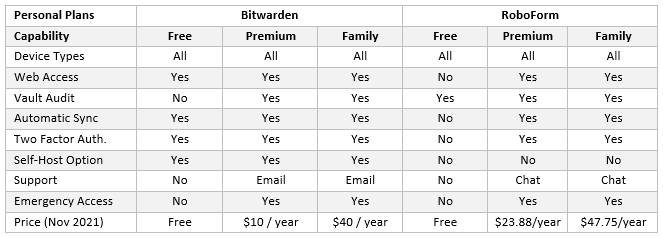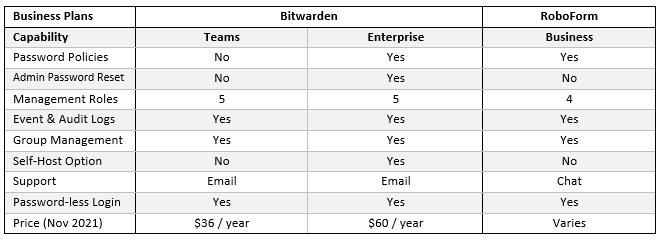When RoboForm launched in 1999, it was one of just a few password managers that worked across different devices and operating systems. It not only auto-filled usernames and passwords, but also payment details, addresses, and other personal information. Over time, the capabilities of RoboForm increased to satisfy customer demands, but how does it compare to a latest-generation password manager such as Bitwarden?
More than twenty years on, the market for password managers is a lot more crowded. As well as browser password managers such as Chrome that synchronize data across different devices (as long as you use Chrome on each of them), there are operating system password managers such as iCloud Keychain that work across Apple devices. Both these types have their limitations unless you work and play on the same operating system or use the same browser all the time.
Vault-based password managers such as RoboForm and Bitwarden overcome the limitations of browser and operating system password managers by storing log-in credentials and other personal information in a vault which can be accessed via the web, and/or via an app, and/or or via a browser extension depending on the type of plan. Advanced users can also operate most vault-based password managers via a command line and/or public API.
To encourage individuals to adopt password managers for their personal use, vendors frequently offer “freemium” plans. Typically, these consist of a free feature-limited password manager which you can upgrade to a fully-featured password manager by paying a subscription. Thereafter, most vendors offer family plans and a range of business plans – which can vary in price depending on the number of users and the features included in the plan.
Bitwarden versus RoboForm Free Service
As most individuals start their password manager journeys with the free service, that´s where we´ll start our comparison of Bitwarden versus RoboForm. Both vendors offer a free service, but there are significant differences between the two. For example, while you can access your personal Bitwarden vault from any device via the web, or from a selection of desktop apps, mobile apps, and browser extensions, you can only access a personal RoboForm vault from non-synchronizing apps.
The lack of automatic synchronization across devices on RoboForm´s free service can be a problem if (for example) you create an account on your home PC and then try to log into the account from your mobile. If you opt for Bitwarden´s free service, this problem doesn´t exist. However, Bitwarden doesn´t provide a vault audit feature in its free plan that enables you to identify reused and compromised passwords – although you can use a free password strength tester to identify weak passwords.
One further difference between the free plans is that Bitwarden supports two-step login via email or authenticator app (i.e., Authy). Two-step login – also known as two-factor authentication – adds an extra level of protection to accounts in order to eliminate threats such as brute force attacks and phishing. As a new One Time Passcode (OTP) is required every time you log in using two factor authentication, it reduces the importance of checking for reused and compromised passwords.
Bitwarden versus RoboForm Premium Service
The gaps in both providers´ free services are filled in when you subscribe to a premium service. Bitwarden provides access to vault audits, while RoboForm provides web access, synchronizes data automatically, and supports two-step login. Both providers also offer enhanced customer support, encrypted file sharing, and the option to grant emergency access to your vault to a trusted contact in case you forget your master password or wish to leave a digital legacy.
In addition to individual premium plans, both Bitwarden and RoboForm offer family premium plans – Bitwarden for up to six family members, RoboForm for up to five family members. Both plans can make financial sense if multiple members of the same family would use a password manager, but it is worth noting that Bitwarden also offers a free two-person plan which has the same features as the free individual plan – ideal if you and a partner share the same Netflix or Deliveroo account.
With regards to the cost of the premium plans, Bitwarden is far more transparent – charging $10 per year for an individual premium plan and $40 for a family premium plan. To find the cost of RoboForm´s premium plans, you have to go halfway through a purchasing process designed to appear as if you are getting a discount for buying now or subscribing for longer than one year (we´ve quoted the advertised full price for one year – there are no discounts for longer subscriptions).
Bitwarden versus RoboForm for Businesses
When it comes to using a password manager for business, the requirements can be much different than for personal use. Businesses want visibility into what passwords are being used, how they are being used, and who they are being shared with. Consequently, it can be important that business plans include features such as audit logs, directory integrations, and policy engines. RoboForm provides all these features in its business plan. Bitwarden has a slightly different approach.
Bitwarden provides two business plans – one for “Teams” and one for “Enterprises”. Unlike the name suggests, the “Teams” plan supports an unlimited number of users and what distinguishes one plan from another is the features included in each plan – the “Teams” plan being feature-limited, while the “Enterprises” plan having everything businesses of all sizes require to fully manage log-in credentials. Nonetheless, the “Teams” option does give businesses a choice about costs.
With regards to the cost of RoboForm´s business plan, it varies according to the number of users and length of subscription (you actually do get a discount for a long-term commitment this time). Prices start from $22.95 per user per year for businesses with 999 employees that commit to a five year subscription and increase to $39.95 per user per year for small businesses committing to a one year subscription. Businesses with more than 1,000 employees should apply for a custom quote.
Bitwarden versus RoboForm for Bugs
Although RoboForm´s business plan beats Bitwarden on price, RoboForm for business only represents better value-for-money when it works. Unfortunately, the software used by RoboForm is exceptionally buggy and updates are frequently being rolled out. RoboForm´s Version News pages do not reveal how long an issue has been impacting customers, but a brief browse through the vendor´s social media channels suggests some bugs are not fixed promptly.
In comparison, Bitwarden is built on open-source software that is constantly being vetted by the open-source community (Bitwarden offers a reward to anybody who finds a bug in its software). Consequently, when a bug is identified, its identification is public, and the fix is virtually immediate. Additionally, the code used for the Bitwarden password manager is published on GitHub and, in some cases, the person who identifies the bug also proposes the fix.
There´s no suggestion that RoboForm is less secure than Bitwarden because of the bugs as both vendors operate under a zero knowledge model in which it is impossible for anybody other than the user to decrypt the contents of their password vault. Nonetheless, if you had just convinced your employer to invest thousands of dollars in a five-year premium plan, and found the platform is unusable due to the volume of bugs, you would not be very happy.
Conclusion: Take Advantage of Free Trials Whenever Possible
The conclusion to take away from our comparison of Bitwarden versus RoboForm is that there is no one-size-fits-all password manager for individuals or businesses. Consequently, individual users are advised to try both vendors´ free accounts before upgrading to a premium plan if necessary (not forgetting that couples can take advantage of Bitwarden´s free two-person plan), while businesses are advised to take advantage of the free trails offered by both Bitwarden and RoboForm.
Bitwarden versus RoboForm FAQs
Is there really no customer support with the free password manager?
Both Bitwarden and RoboForm have comprehensive Help pages on their websites and monitored Reddit threads where you can ask questions to company representatives. Bitwarden also has a GitHub community and hosts a community forum on its website – offering loads of practical advice and answering customer questions regardless of their subscription status.
Is it possible to apply password policies on the free, premium, or family plans?
Not at this time. However, both Bitwarden and RoboForm have random password generators than can be configured to generate passwords of a minimum length and complexity. Once the passwords are generated, you copy and paste them into the password manager to create new strong passwords and replace old weak passwords.
Is it possible to set reminders for when passwords need changing – i.e., every 90 days?
Up until recently, it was recommended users change passwords periodically. That advice was revised in March 2020 when NIST´s Digital Identity Guidelines reported users were making only minor changes to existing passwords (i.e., “passwordfor2020” > “passwordfor2021”) and if the original password had been hacked, there was a strong likelihood its replacement would be as well.
NIST now recommends the use of passphrases or strong, unique passwords for each account supported by two-factor authentication. Consequently, password managers no longer include features to remind users to change passwords – instead providing capabilities such as two-step login to better secure accounts and data.
What difference does it make that Bitwarden for business has an additional management role?
Bitwarden´s management hierarchy is very different from that of RoboForm for business. Bitwarden´s management roles consist of the account Owner, system Admins, group Managers, and Users. The fifth management role is a Custom role that can be configured to apply conditions to Admins, Managers, and Users.
RoboForm´s four management roles start with Company Admins, followed by Group Managers, Regular Users and Limited Users – Limited User being unable to view or edit login credentials, but able to access shared notes and contacts in read-only mode. There is no option to customize management roles in RoboForm for business.
Why might a business want to self-host Bitwarden?
When you save data in a Bitwarden vault, so that it can be synchronized across all devices, an encrypted version of the data is sent to Bitwarden´s servers which are hosted in the Azure Public Cloud. The Azure Cloud has dozens of Regions and, within them, multiple Availability Zones, so there is no knowing exactly where your data is.
The option of self-hosting is provided for businesses that operate in regulated industries such as healthcare or finance where the requirement exists to know where sensitive data is at all times. However, if you are thinking of taking advantage of this option, please be aware you need a fair amount of technical knowledge to in


